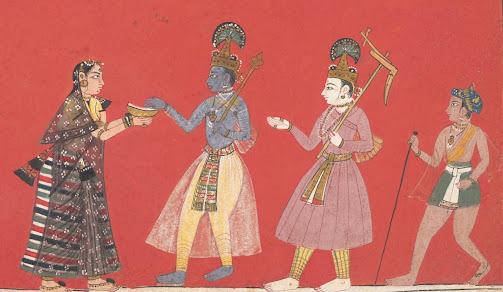Sairindhī's qualifications
"I am not able to abandon even Sairindhri (Kubja), O Uddhava! So how can I abandon the residents of Vraja?" In order to reveal this truth, Krishna went to Kubja's home to enjoy with her.
sairindrīm api santyaktum ahaṁ śakto’smi noddhava !
kim uta vraja-lokāṁs tān iti vyañjann imām agāt ||
"I am not able to abandon even Sairindhri (Kubja) O Uddhava! So how can I abandon the Vrajavasis?" In order to reveal this truth, Krishna went to her home to enjoy with her.
Chapter 48 immediately follows the two chapters describing Uddhava's visit to Vraja.
śrī-sairindhryai namas tasyai yat-kṛpākṛṣṭa-mānasaḥ |
svayaṁ gṛhaṁ gato rantum asaṅkocaṁ ramāpatiḥ ||
I bow down to Śrī Sairindhrī to whose home the husband of the Goddess of Fortune went without any hesitation, being drawn there by the desire to show her his mercy.
This verse is calqued on that of Sanatana Goswami, which reads a little differently:
śrī-sairindhyrai namas tasyai yasyā bhāva-niyantritaḥ |
svayaṁ grhaṁ gato rantuṁ nāgarī-gaṇa-vallabhaḥ ||
I bow down to Śrī Sairindhrī to whose home the lover of the intriguing city women went, being controlled by her love.
So what is interesting here is that in Prīṭi Sandarbha 155, Sri Jiva is coming near to the end of his lengthy discussion of uddīpanas, which was dominated by the listing of Krishna's qualities and an analysis of them, but also other exciters of love for Krishna in a devotee like His embellishments (i.e., clothes and ornaments like garlands, etc.), weapons, musical instruments (like the flute or conch), places (like Vrindavan), symbols (like the footprints, etc), entourage, devotees, tulasī and, finally, His leftovers or remnants (nirmālya).
JG concludes Anuccheda 155 with the following statement: "A devotee's qualification (yogyatā) is also seen to act as an uddīpana for love for Krishna." Now ordinarily we would think that a devotee's yogyatā is in his or her adhering to a good committed and disciplined devotional life and so on, like the qualities described in many places in the Gīṭā, Bhāgavata and Bhakti-rasāmrita-sindhu (such as 1.3.25-26, CC Madhya 23.18-19), but JG is in the domain of līlā here, not of sādhana-bhakti. Nevertheless, he surprises us with the following verse as the example:
tato rūpa-guṇaudārya-sampannā prāha keśavam |
uttarīyāntam ākṛṣya smayantī jāta-hṛc-chayā ||
Trivakrā, who had become endowed with beauty, good character and generosity [by Krishna's action of straightening her back], felt her desires awaken and she spoke to Kṛṣṇa with a smile on her face as she tugged on His upper cloth. (SB 10.42.9)
This is an interesting example because it is not the usual kind of devotee qualification that is being spoken of. Is her qualification that Krishna's mercifully transformed her from an ugly hunchback to a beautiful courtesan?
In 10.48.5 we have another verse in which the commentaries speak of Sarindhrī's qualification for Krishna's lovemaking (rati-yogyatā).
sā majjanālepa-dukūla-bhūṣaṇa-
srag-gandha-tāmbūla-sudhāsavādibhiḥ |
prasādhitātmopasasāra mādhavaṁ
sa-vrīḍa-līlotsmita-vibhramekṣitaiḥ ||
Trivakrā prepared herself by bathing, anointing her body, and dressing in fine garments, by putting on jewelry, garlands and perfume, and also by chewing betel nut, drinking fragrant liquor, and so on. She then approached Lord Mādhava with shy, playful smiles and coquettish glances.
But she has sādhāraṇī rati, so why select her example here? Part of the answer is no doubt in the kaimutyika-nyāya expressed in Jīva Gosvāmī's introductory verse to 10.48: If Kubjā can receive this grace from Krishna, then what to speak of the Vrajavasis and most of all the gopis. So how much more qualified are they and how much more of an inspiration!
See also




Comments